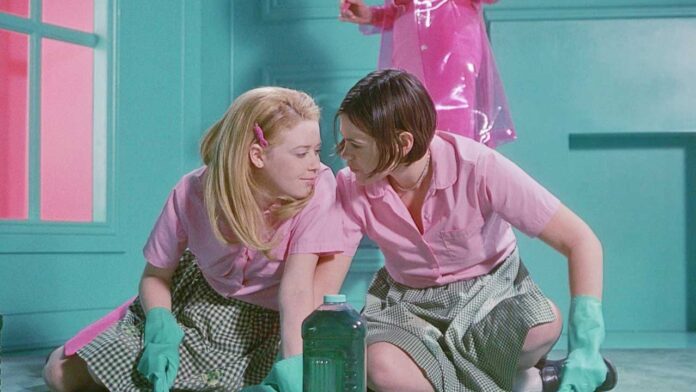For its 20th Anniversary, out lesbian filmmaker Jamie Babbit’s feature debut, the cult comedy, “But I’m a Cheerleader,” is being reissued in a Digital 4K Ultra HD Director’s Cut on December 8. The film was ahead of its time in its depiction of camp, conversion therapy, and queer coming of age tropes when it received its original theatrical release in the summer of 2000.
The plot has Megan (Natasha Lyonne) being sent to True Directions, a program run by Mary (Cathy Moriarity) to prevent her from living a homosexual life. While Megan protests that she is not gay, she soon become attracted to Graham (out actress Clea DuVall). The film, shot in candy-colored pinks and greens, skewers gender roles with a wink-wink sensibility.
The film received mixed reviews on release and generated some controversy when it was initially slapped with an NC-17 rating. (Babbit edited “Cheerleader” to earn it an R.) But it has since become a queer cinema classic. Babbit, who added a few scenes she loved back in for this version, spoke with PGN about her new old film.
Looking back on this film after 20 years, what can you say about making “Cheerleader?”
It’s all about the long game! The fun things about the director’s cut release was that I got to look back on some of the scenes I deleted 20 years ago. I loved the scene of Cathy [Moriarity] playing the guitar. That scene was inspired by my mom singing songs to teens at a [drug] rehab. It was great to be my own artistic encouragement 20 years later. My reflection on my twenty-something self was “Good for her, she did a great job!” But I was nervous about expressing something so personal and putting it out in the world. The ‘90s were a different time in the queer movement — the legacy of AIDS and the horrors of this plague in gay community meant a lot of people weren’t willing to laugh. But “Cheerleader” makes fun of straights, and gender non-conformity, but also the queer community. And I don’t want to be part of a community I can’t make fun of. I was poking fun from the inside. If you want to make fun of a community, you better be part of it.
What about the film’s value as a coming-of-age story? It may be a queer “coming out” film but it goes beyond that in its messages about gender roles and social influence. You practically play up the stereotypes to show them as normal.
It was a personal film. I was in my 20s, so all that was very real to me. When I was coming out, I was trying to find a butch identity. It’s separating yourself from people’s and the community’s expectations. That’s why Larry and Lloyd say, “There is no one way to be gay and be yourself.” Declare your individualism — whatever that is.
The film has a very distinctive tone. It’s not just the broad humor and campiness or the bright color palette, it’s the gay power vibe that will win against all oppression. Can you talk about that aspect of the film?
I was interested in gender politics at the time, which people weren’t really talking about. As a femme lesbian, I felt I wasn’t allowed to be a lesbian because I’m not butch. There was an invisibility of femme lesbians. I was interested in the construct of gender and how ridiculous it is; this idea of men doing less girly/women doing less boyish things makes you less gay. A toy store shows how gender is and what boys and girls should be. We bought the Barbie Dream House, and I said, “This is what the movies should look like!”
What can you say about the film’s depiction of conversion therapy? This was the first feature film to tackle this insidious practice.
Conversion therapy still exists worldwide. It is very alive in South Africa, in Scientology and in Christian communities. Exodus may be gone, but there are millions of other start-ups. It is so damaging for [queer] kids, trying to figure out who they are, having a pastor or religious figure telling them there’s another way out and programming them to hate themselves. It is very damaging. The more of these programs that are outlawed the better.
Your film was a comic response to the rebellious New Queer Cinema films of the time. What observations do you have about that? Do you think that had an impact on its reception?
I was younger, and a woman, so I had a different view. I was part of a newer generation coming up after the Queer New Wave. Every 5 years makes a difference, and I was on the cusp of all of that stuff. I have always had a wry sense of humor. I was involved in the Riot Grrrl movement, and they were great at empowering girls like me to make queer art however you want, and not copy others. I was pure to myself and my own instincts. Gregg Araki saw my film and said it was the gayest movie he’d ever seen. I wasn’t sure if it was a compliment or a dis. He was taken aback by how out and gay “Cheerleader” was.
Jamie Babbit’s new film, “The Stand In” will be available on demand December 11.

